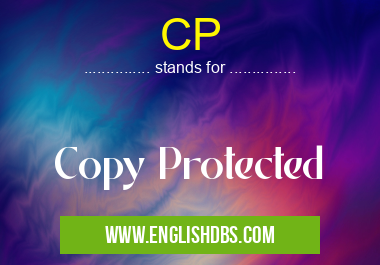What does CP mean in CYBER & SECURITY
CP or Copy Protection is the term used to describe the technology that prevents content from being copied and redistributed. It can be applied to any kind of digital media, such as videos, music, ebooks, software, etc. This technology has become increasingly popular in order to protect copyright owners from piracy and illegal sharing. In this article we'll look at what CP means in computing and how it is used in order to protect copyrighted material.

CP meaning in Cyber & Security in Computing
CP mostly used in an acronym Cyber & Security in Category Computing that means Copy Protected
Shorthand: CP,
Full Form: Copy Protected
For more information of "Copy Protected", see the section below.
Essential Questions and Answers on Copy Protected in "COMPUTING»SECURITY"
What is Copy Protection?
Copy protection (also known as content protection, copy prevention and copy restriction) is a technology used to prevent the unauthorized duplication of certain types of media. It can be applied to any type of digital media or content, including audio, video, software, images, etc.
How does Copy Protection work?
Copy protection works by preventing users from making copies or sharing files with others. This can be done through several different methods, such as encryption, watermarking, and digital rights management.
What are the benefits of using Copy Protection?
The primary benefit of using copy protection is that it helps protect creators and their intellectual property from being copied without permission. This can help ensure that creators receive appropriate royalties for their work and discourage piracy.
What types of media can be protected with Copy Protection?
Any type of digital media or content can be protected with copy protection. This includes audio, video, software, images, documents, and more.
Are there any drawbacks to using Copy Protection?
While copy protection offers many benefits for protecting content creators’ intellectual property rights, there are some drawbacks associated with it as well. For example, it may limit how users interact with the content they have purchased or make it more difficult to access on multiple devices or locations.
IsCopy Protection only effective against illegal downloading?
No - while copy protection does help protect against illegal downloading or file sharing activities, it also helps protect digital content from being copied without permission in other ways too - such as saving copies to removable storage devices like USB drives or backing up copies onto personal computers.
Who needs to use Copy Protection?
Anyone who creates digital content should consider using some form of copy protection in order to protect their intellectual property rights against unauthorized duplication or distribution.
How do I know if my content is secure with Copy Protection?
There is no way to guarantee complete security for your digital content since any kind of security measure has its own limitations and risks associated with it. However by using an effective copy protection solution you can significantly reduce the risk of your content being illegally distributed online.
Final Words:
In conclusion, CP stands for Copy Protection and refers to the various technologies used to restrict the copying and distribution of copyrighted material without permission from the copyright holder. The exact method used will vary depending on the type of media being protected and whether it’s online or offline but overall its purpose remains to protect intellectual property rights while still allowing users access where appropriate.
CP also stands for: |
|
| All stands for CP |
